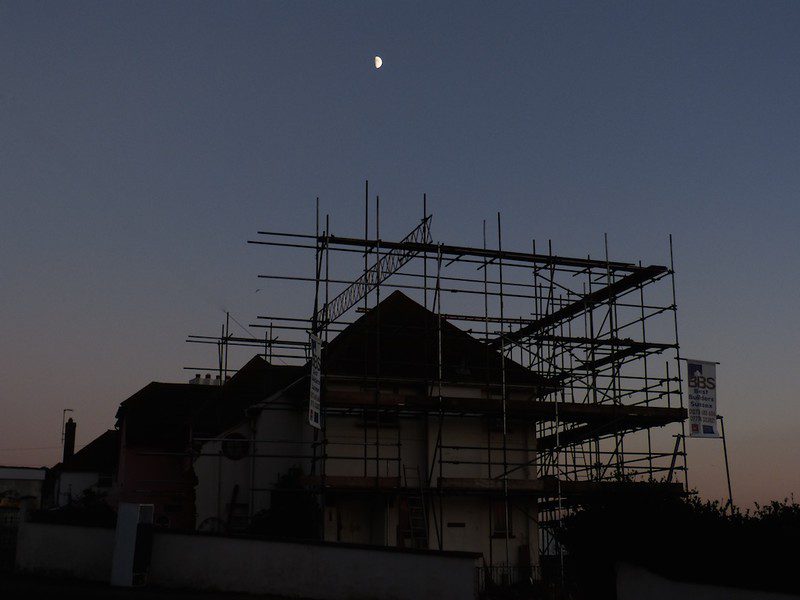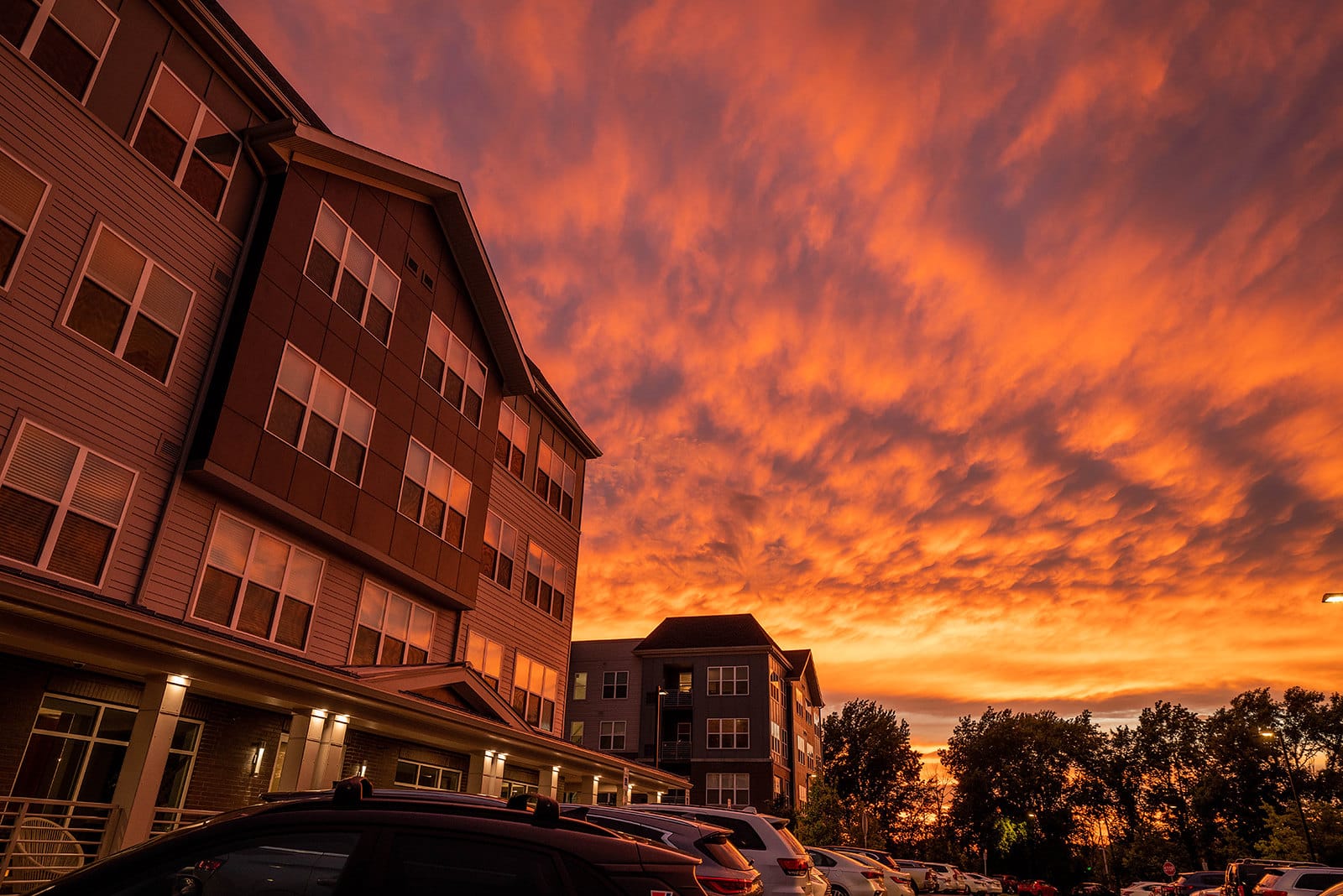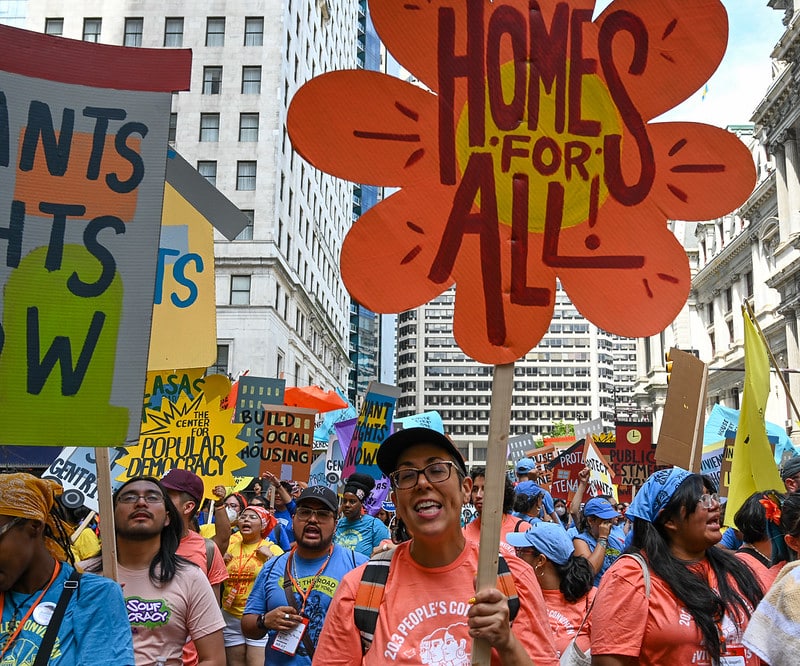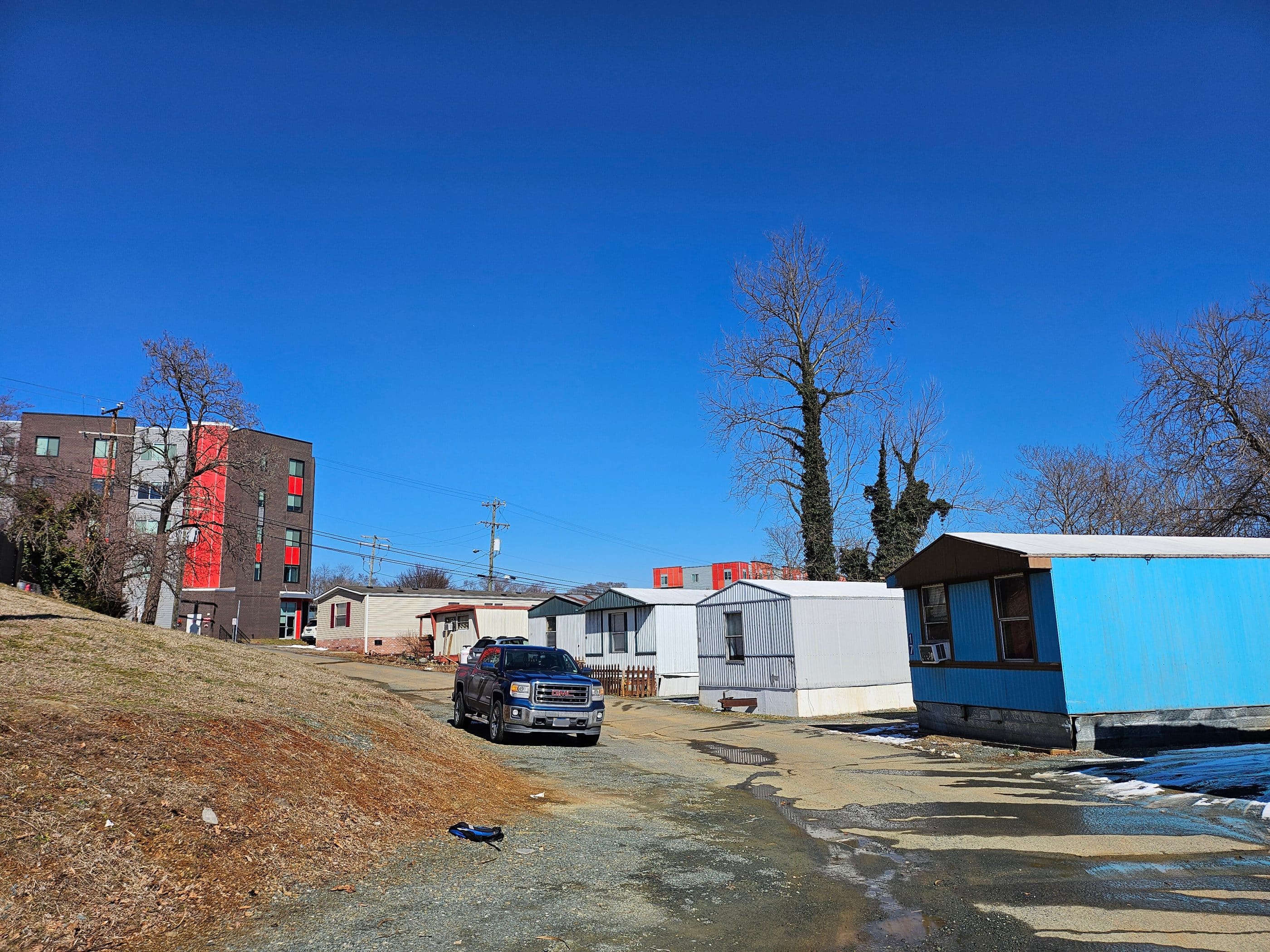
Photo by Flickr user Les Chatfield, CC BY 2.0
Earlier this year, HUD released its annual point-in-time count illustrating the state of homelessness in the U.S. The conclusions were sobering.
According to the report, the nation’s homeless population has been growing since 2016; on a single night in 2020, roughly 580,000 people experienced homelessness. And for the first time since the count began in 2007, the number of single adults living on the street exceeded that of those living in shelters.
Advocates agree that those figures are most likely an undercount—in part because of the pandemic, which began shortly after the count concluded.
The problem is huge and challenging, but there are some proven solutions. In particular, permanent supportive housing has been repeatedly shown to work for chronically homeless people, especially those with mental illness, which is somewhere around one-third of the total group. Providing them with a long-term home and wraparound services like intensive case management, health care, and workforce development stabilizes a vulnerable population that would otherwise remain at the very fringes of society. It’s critical too for non-homeless adults with mental illness, a population that’s often just a few bad days away from winding up on the streets.
The solution is cost-effective. Amounts vary depending on location, but chronically homeless people with mental illness often have complex medical issues as well and can rack up tens of thousands of dollars annually in frequent visits to emergency rooms and repeat stays in detox programs and jails. Simply providing housing for them can reduce those public costs by half. But housing combined with services decreases public expenditures by 79 percent. And most importantly, it can help chronically homeless people return to productive, engaged lives.
But while there are roughly 373,000 permanent supportive housing beds around the U.S., that’s not enough to meet the need—and what does exist is threatened by rising housing prices. In 2020, the number of permanent supportive housing beds earmarked specifically for chronically homeless people declined for the first time since 2007. Increasing the supply isn’t cheap: in 2019, the per-unit cost of brick-and-mortar housing plus services that comprise permanent supportive housing ranged from $21,000 to almost $40,000, depending on location. And that price is often paid in the form of an up-front, lump-sum figure that can be dauntingly expensive and politically unattractive, despite the ultimate savings.
In response, advocates and policymakers have developed creative financing methods to build and maintain supportive housing, and to help the public and local government officials get on board with the concept. Over the past five years, for example, groups in Denver, Los Angeles, and the Bay Area have initiated permanent supportive housing projects that feature lower overall costs, greater efficiencies, and partnerships with foundations and the private sector.
Initiatives like these can help win the support of a public that has become outraged but also fatigued with the rising numbers of homeless people around them.
Using Social Impact Bonds to Bring in Investors
About a decade ago, Denver’s Crime Prevention and Control Commission noticed that many people who were frequently detained in the local jail were chronically homeless people, and commission members began seeking ways to slow their cycling through emergency services. So in 2012, when the mayor’s office solicited proposals for social programs that could potentially reduce city expenditures, the commission’s director applied.
Four years later, that issue—studied and broadened—launched as the focus of the city’s first social impact bond. Developed in 2010, social impact bonds—also known as pay-for-success models—utilize private investors to fund social services that eventually pay for themselves. If that occurs, investors get their money back with interest. In this case, homeless advocates, researchers, and policymakers had determined that roughly 250 chronically homeless people were costing the city around $7 million per year in services, including visits to the emergency room, and stays at detox facilities, short-term shelters, and the city’s jail. They made a bet that providing housing plus wraparound services for them would save the city money.
The initiative was managed and designed by the Corporation for Supportive Housing and Enterprise Community Partners, and included service providers like the Colorado Coalition for the Homeless and the Mental Health Center of Denver. Eight private investors put up a total of $8.6 million; if the project kept program participants housed for 365 days with no breaks—in jail or elsewhere—for more than 90 days, the city would repay the investors. If it didn’t, the investors wouldn’t get their money back.
In 2016, the Colorado Coalition for the Homeless identified over 500 chronically homeless people who were frequently detained in the city jail. Half, the control group, remained unhoused as before. The other 250 were brought into housing paired with robust services that followed an assertive community treatment model, utilizing interdisciplinary and collaborative assistance teams.
Throughout, evaluators from the Urban Institute and University of Colorado Denver monitored the program. After the first year, a majority of participants remained stably housed, and the city began paying investors back. In fact, Denver’s mayor was so impressed with the results that he requested funding from the city budget to add another 100 participants to the rolls.
The program concluded at the end of 2020, and results released in July 2021 showed that it was a success. According to the evaluation, more than half of the initiative’s total price tag was offset by decreases in the use of emergency services. (Those figures don’t include the use of emergency departments; health care costs weren’t part of the initiative.) Investors were fully compensated for their original contributions, plus another $1 million in interest that they were paid by the city.
It hasn’t been without a few controversies, however. First, John Parvensky, president of Colorado Coalition for the Homeless, points out, “It’s a bit of a fallacy to say that $9 million was raised by this investment group to create permanent supportive housing to serve 250 people.” In reality, the funding from investors was used specifically for services. The actual housing came in part from a Low-Income Housing Tax Credit project that the coalition happened to be developing at that time, as well as from housing vouchers that were applied to privately owned units. The total cost, therefore, was significantly more than $9.6 million.
But Parvensky, whose organization is about to begin a new social impact bond project led by the federal government, explains that the housing might not have been approved had it not been for the project’s high profile. “Tax credits are competitive. And getting vouchers is also competitive,” he says. “Being able to leverage all these other resources—that made a compelling case to the housing authority and the housing finance agency.”
And that’s linked to the other controversy. A couple of Denver’s council members originally voted against the project because they felt the city should fund it outright, rather than hide behind the private sector and wind up having to shell out an extra $1 million in interest. It’s a valid complaint, says Parvensky. After all, his organization has been building permanent supportive housing for over 25 years and had already proven that it works. He admits to having done a bit of an eyeroll when the social impact bond project was first proposed.
But in addition to the housing approvals that occurred largely because of the project’s shiny status, there were other advantages. Funding was upfront, with few strings attached, and at the end, one of the investors shared $200,000 of their windfall with the coalition. Arguably more important, the rigorous evaluation done by the Urban Institute and its partners is out in the public sphere, clearly demonstrating to other governments permanent supportive housing’s effectiveness.
There was one other significant benefit, says Mary Cunningham, the Urban Institute’s principal investigator on the project. There tends to be a myth among the public that homeless people want to be on the streets, and that there’s nothing that can done about them. But this project, she says, dispels that idea. “It was really based on outcomes from people who weren’t seeking services.” That is, when housing and services are amply provided, homeless people respond positively.
Collaborating for Better, Faster, and Cheaper Housing Production
In Los Angeles, advocates, policymakers, and the public have been grappling with a similar problem—but on a much bigger scale. In 2015, Los Angeles County conducted a point-in-time homelessness survey showing that the county’s homeless population had risen to almost 45,000, a 12 percent increase over 2013. The problem had become far too big to ignore.
But the city’s agencies and organizations hadn’t been unaware of the issue. Representatives from institutions like the California Community Foundation, the Hilton Foundation, the Weingart Foundation, and the Kresge Foundation (which supports some of Shelterforce’s work), as well as from the city, the county, and organizations like the Corporation for Supportive Housing, had been meeting since 2011 in a collaborative led by the United Way to collectively develop and implement potential solutions.
“It’s an organic ecosystem: a symbiotic relationship of good old-fashioned leaning on each other,” says Tommy Newman, vice president of engagement and activism at United Way, describing the group.
Los Angeles had been lacking a dedicated revenue source for permanent affordable housing that could help the unsheltered people documented in the survey. In 2015, both the city and county were creating broad strategies to address homelessness; together, with input from other members of the collaborative, they gradually worked out a joint approach. In November 2016, the city put Proposition HHH on the ballot; it was a $1.2 billion bond measure that would raise property taxes to ensure that a total of 10,000 units for chronically homeless people were built over the course of a decade. And the following spring, the county sponsored Measure H, which would add a quarter cent to the county’s sales tax to generate roughly $355 million per year for 10 years to pay for services and rental subsidies.
The California Community Foundation put funding behind the referendums’ campaigns, and the United Way and others contributed staff time. “We did direct mail to voters, radio, digital ads; we led a project to write 100,000 handwritten postcards to people in support of the measure,” recalls Newman. “The [HHH] campaign got the most ‘yes’ votes of any bond proposal in the history of the city of LA.” Similarly, Measure H passed with almost 70 percent approval.
But the team of funders didn’t rest on its laurels. Throughout, members were devising complementary ways to expand and hasten the number of permanent supportive housing projects being built in the region. “We said, ‘If we’re going to scale HHH, we have to grow the predevelopment loan fund and increase capacity among developers,’” remembers Andrea Iloulian, a senior program officer for homelessness with the Hilton Foundation.
By 2017, foundations had contributed funding to increase an existing Supportive Housing Loan Fund, which provided predevelopment and acquisition funds to developers, to $60 million. They’d also helped to pass the Permanent Supportive Housing Ordinance, which streamlines projects’ design review process and eases zoning requirements for affordable housing projects that reserve a majority of their units for supportive housing. And they created a grant fund to help affordable housing developers hire staff and boost capacity. In 2020, other funders launched a new $10 million fund to accelerate supportive housing development.
Some of these initiatives bore real fruit. But in a city like LA, with sprawling government agencies and high costs, developing affordable housing can move at a snail’s pace, even with the presence of policies designed to expedite the process.
By early this year, the public was loudly complaining that it hadn’t seen much progress resulting from Proposition HHH. “It took more than three years for the first unit to open; fewer than 500 units opened in the first five years,” wrote a local magazine recently.
But Maria Cabildo, director of housing and economic opportunity at the California Community Foundation, says the public doesn’t necessarily realize how complex affordable housing development can be. And because the new projects are utilizing public money, their developers must comply with government requirements: soliciting public engagement, paying a legal wage, and designing ADA-compliant units. “You can’t have all this policy to create the perfectly constructed affordable housing project, and then criticize it as being too expensive,” she says.
In addition, land costs have sharply risen in the five years since HHH passed, and COVID-related supply chain issues have led to sky-high prices for materials. Proposition HHH was specifically designed so that developers would only have to utilize a few funding sources, but now they’ve had to pull their financing from many places—which again adds to a project’s timeline and ultimate cost.
But, says Cabildo, “Despite what you hear on the street in LA, it’s a very successful program.” Indeed, over 8,300 units—out of the total goal of 10,000—are currently in the development pipeline.
The collaborative of funders and others is still meeting and devising new programs. “Costs are accelerating like never before. There’s lots of interest in new, innovative models,” says David Howden, director of the Corporation for Supportive Housing’s Los Angeles office. “We’re really concentrating on the public side, where streamlining efficiencies, concentrating funding, and getting to true by-right zoning can do things better, faster, and cheaper.”
Preserving Supportive Housing Through a Community Land Trust
California’s Bay Area has also been experiencing an extreme homelessness crisis; a 2017 point-in-time survey counted roughly 28,000 unhoused people in the region. About 20 percent of those people are in Alameda County, which is home to Oakland and several smaller cities.
Like other counties and municipalities, Alameda has been working hard to build new affordable housing units to address the problem. But an innovative organization just getting off the ground there is tackling the issue from a different direction: trying to keep people with serious mental illness from becoming homeless in the first place.
The Supportive Housing Community Land Alliance (SHCLA) launched last year with the goal of utilizing a land trust model to preserve and grow permanent supportive housing options. It’s a pilot project and a brand-new concept that will marry several key considerations.
One the one hand, the region’s rising housing prices have deeply affected spaces often used by people with serious mental illness. In particular, group homes—also known as board and care facilities—have been closing at a rapid clip throughout the region. Between 2014 and 2017, 50 board and care or independent living facilities in Alameda County were either sold or closed, leaving roughly 500 people without a home and with few options.
At the same time, employees at Alameda County Behavioral Health Care Services (known as BHCS), which birthed SHCLA, were hearing parents of adult children with mental illness voice worries about what would happen to their kids when they were no longer around.
That’s when BHCS leaders got the idea, says Karen Nemsick, who has been helping to set up the new organization. The concept, she explains, was, “What if we acquire board and cares before they close, and launch a community land trust to purchase the homes for family members—and make sure the house is stewarded by the land trust and can’t be taken out from under the adult kids?”
That is, kill two birds with one stone. SHCLA would buy the board and care homes that would otherwise disappear, and it would do so utilizing a land trust model: the land would remain owned by the organization, which would allow the facilities to be purchased at an affordable price by family members. Importantly, the residences would remain viable for the community in perpetuity.
The group acquired a large grant last year that has allowed it to begin setting up a board and an advisory committee, both comprising people with serious mental illness as well as family members and practitioners. SHCLA will be membership based, which means that residents—who will be primarily low-income people and people of color—will have a voice in the organization’s policies, services, and activities.
SHCLA’s properties will provide a variety of levels of care, from fully supported living to semi-independent, and that will help it procure funding from a range of sources: Alameda County’s Continuum of Care program, county HOME bond funds, state housing initiatives, and funding earmarked specifically for the acquisition and preservation of board and care homes.
Nemsick and her colleagues are excited about the possibilities before the organization. “We’ll be able to preserve housing that helps people at all levels of the continuum of care, because of the flexibility we’ll have from purchasing smaller properties to bring into the land trust.”
They also imagine partnering with related organizations to preserve more funding. “We could get funding to acquire land, [other organizations] may have funding to do something similar, and we could stretch the funding—and acquire twice the properties,” says Dev Goetschius, a partner with Burlington Associates in Community Development who is a consultant for SHCLA. “We’re very much in an innovative state.”
And that’s a good thing. Because with a national housing and homelessness crisis, these innovative ideas—backed up by funding—are the only things that will make a difference.




Comments